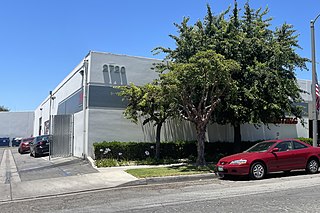IBM LAN Server is a discontinued network operating system introduced by International Business Machines (IBM) in 1988. LAN Server started as a close cousin of Microsoft's LAN Manager and first shipped in early 1988. It was originally designed to run on top of Operating System/2 (OS/2) Extended Edition. The network client was called IBM LAN Requester and was included with OS/2 EE 1.1 by default. Here the short term LAN Server refers to the IBM OS/2 LAN Server product. There were also LAN Server products for other operating systems, notably AIX—now called Fast Connect—and OS/400.

The LTE is a line of laptops manufactured by Compaq Computer Corporation, introduced in 1989 and discontinued in 1997. It was the first notebook-sized laptop sold by Compaq and the first commercially successful notebook computer, helping launch the burgeoning industry.

ServerWorks Corporation was an American fabless semiconductor company based in Santa Clara, California, that manufactured chipsets for server computers and workstations running IA-32 microprocessors. Founded as Reliance Computer Corporation in 1994, it filed its initial public offering in the beginning of 2000 and was acquired by Broadcom for nearly US$1 billion.

The LTE Lite was a series of notebook-sized laptops under the LTE line manufactured by Compaq from 1992 to 1994. The first entries in the series were Compaq's first computers after co-founder Rod Canion's ousting and Eckhard Pfeiffer's tenure as the new CEO. The notebooks were co-developed and manufactured by Compaq and Citizen Watch of Japan. They were a hot-seller for Compaq and spanned multiple models, with various processors and liquid-crystal display technologies.

Reply Corporation, often shortened to Reply Corp., was an American computer company based in San Jose, California. Founded in 1988 by Steve Petracca, the company licensed the Micro Channel architecture from IBM for their own computers released in 1989, competing against IBM's PS/2 line. The company later divested from offering complete systems in favor of marketing motherboard upgrades for older PS/2s. Reply enjoyed a close relationship with IBM, owing to many of its founding employees, including Petracca, having worked for IBM. The company was acquired by Radius in 1997.

American Computer & Peripheral, Inc. (AC&P), also written as American Computer and Peripheral, was an American computer company based in Santa Ana, California. The company was founded in 1985 by Alan Lau and released several expansion boards for the IBM PC as well as a few PC clones before going bankrupt in December 1989. Obscure in its own time, the company's 386 Translator was the first plug-in board for Intel's newly released 80386 processor and the first mass-market computing device to offer consumers a means of using the 386 in July 1986.

The Versa was a line of laptop computers sold by the Japanese electronics conglomerate NEC Corporation from 1993 to 2009. It comprised many form factors of laptops, from conventional clamshell notebooks to pen-enabled convertibles featuring detachable displays, before the line was effectively discontinued in 2009 after NEC pulled out of the global market for personal computers.

The ActionNote was a series of laptop computers developed by Epson America in 1993. The series was Epson's answer to the small businesses and home office market for laptops and initially ran alongside their corporate-oriented NB series of laptops. The series was segmented into premium and low-cost offerings and included a subnotebook, the ActionNote 4000. The bulk of the laptops' manufacturing was performed by ASE Technologies of Taiwan, with the exception of the short-lived initial entries into the 700 series, which were produced by Jabil Circuit. The ActionNote received mixed, mostly positive, reception in its lifespan before Epson America silently left the personal computer market in 1996.

Canon Computer Systems, Inc. (CCSI), sometimes shortened to Canon Computer, was an American subsidiary of Canon Inc. formed in 1992 to develop and market the parent company's personal computers and workstations. The subsidiary also assumed the responsibility of marketing Canon's printers and photocopiers, which were formerly sold by other Canon divisions. It went defunct in January 2001.

DTK Computer is the name for international branches of Datatech Enterprises, a Taiwanese computer manufacturer. Founded in 1981, the company was an early supplier of peripherals for IBM PCs as well as PC compatible motherboards. In the late 1980s, the company switched to developing complete systems under the DTK name as well as serving as an OEM for motherboards and cases, as bought by other small computer companies and systems integrators.

Advanced Logic Research, Inc. (ALR), was an American computer company founded in 1984 in Irvine, California by Gene Lu. The company marketed IBM PC compatibles across that standard's evolution until 1997 when it was acquired by Gateway 2000. ALR had a reputation for beating its larger competitors to market with compatibles featuring cutting-edge technologies. However, it struggled with brand recognition in the fiercely competitive market of low-end PCs in the mid-1990s. According to computer journalist and collector Michael Nadeau, "ALR's business strategy was to be the first to market with the latest and fastest possible PC-compatible designs", a strategy that "often succeeded".

DECpc was a wide-ranging family of desktop computers, laptops, servers, and workstations sold by Digital Equipment Corporation. The vast majority in the family are based on x86 processors, although the APX 150 uses DEC's own Alpha processor. The line was DEC's first big break into the IBM PC compatible market.

OPTi Inc. was a fabless semiconductor company based in Milpitas, California, that primarily manufactured chipsets for personal computers. The company dissolved in 2001 and transferred its assets to the unaffiliated non-practicing entity OPTi Technologies

Aox Inc. was a privately run American technology corporation founded by Michael and Linda Aronson in 1978. Over the course of its 22-year lifespan, the company chiefly developed software and hardware for IBM's PC and compatibles, for the Personal System/2, and for the Macintosh. In its twilight years, the company designed multimedia and teleconferencing devices and chip designs. Aox was founded after Michael Aronson graduated from Harvard University with a doctorate in physics; he stayed with the company until 2000, when he incorporated EndPoints Inc. and switched to full-time fabless semiconductor design.

Cumulus Corporation was an American computer peripheral and system manufacturer active from 1987 to 1993. Based in Beachwood, Ohio and started by Tecmar founder Martin Alpert, the company set out to exclusively manufacture expansion products for IBM's Personal System/2 (PS/2) family of computers—mainly RAM expansion cards. It later released cross-platform CPU upgrade cards and memory expansion cards for other platforms besides the PS/2. Beginning in 1990, the company began trading as Cumulus Computer Corporation and began releasing complete systems of their own. Initially a success story for the tech industry in Cleveland, a botched stock launch in 1992 proved disastrous for the company's ailing cash flow situation, and in 1993 the company was liquidated amid massive debt to suppliers and lenders.

Kayak was a line of x86-based, optionally dual-processor workstation computers released by Hewlett-Packard from 1997 until the acquisition of Compaq in 2002. The Kayak line was aimed at the scientific computing and professional 3D graphics markets and came preinstalled with Windows NT.
Micronics Computers, Inc. was an American computer company active from 1986 to 1998 that manufactured complete systems, motherboards, and peripherals. Based in the San Francisco Bay Area, Micronics was one of the largest domestic motherboard manufacturers in the United States in the 1990s. After acquiring Orchid Technology in 1994, the company entered the market for multimedia products, such as graphics adapters and sound cards. In 1998, Micronics was acquired by Diamond Multimedia.

The LTE 5000 series was a series of notebook-sized laptops under the LTE line manufactured by Compaq from 1995 to 1997. The LTE 5000 series was Compaq's first laptop with Pentium processors from Intel. The line of computers were co-developed between Compaq and Inventec of Taiwan and were manufactured entirely by Inventec overseas. The LTE 5000 series marked the last generation in the LTE line, Compaq replacing it with the Armada line in 1997.














